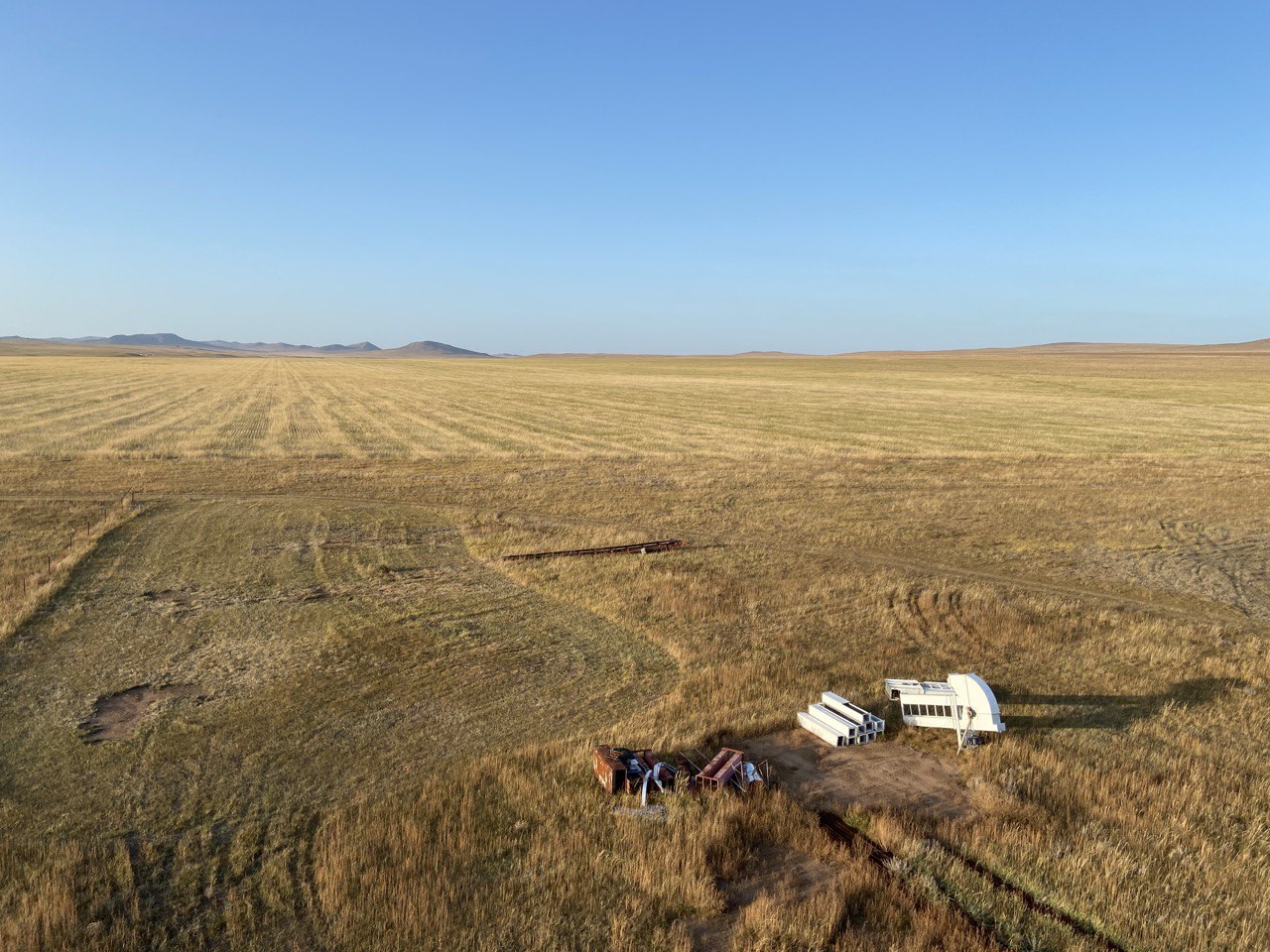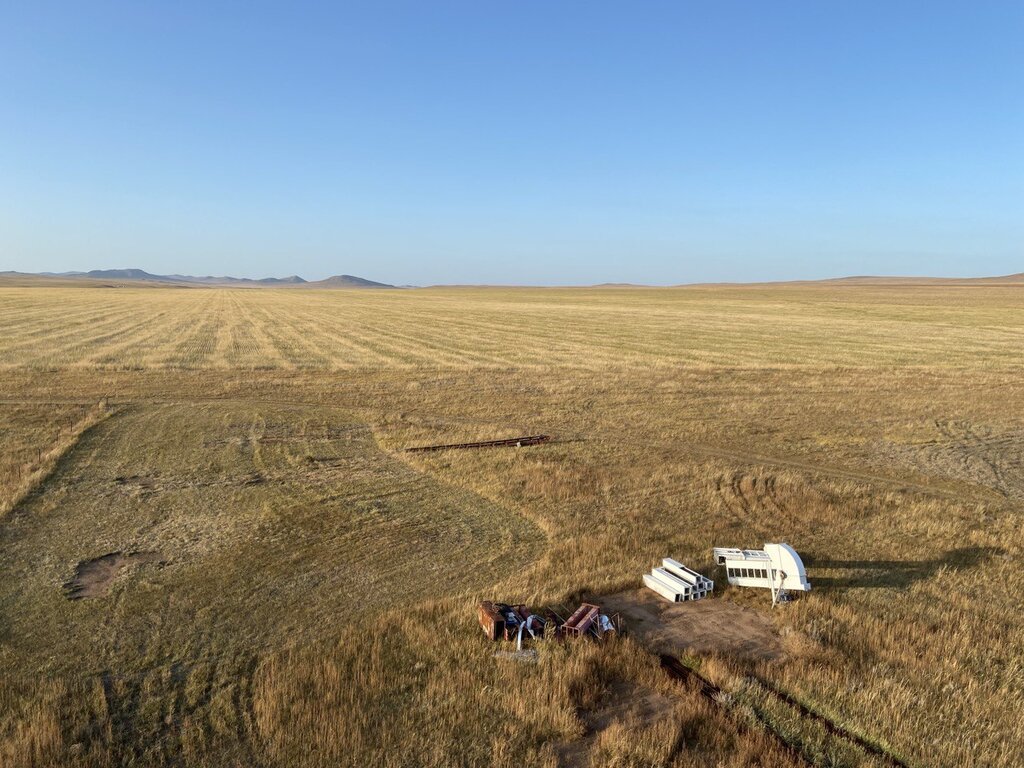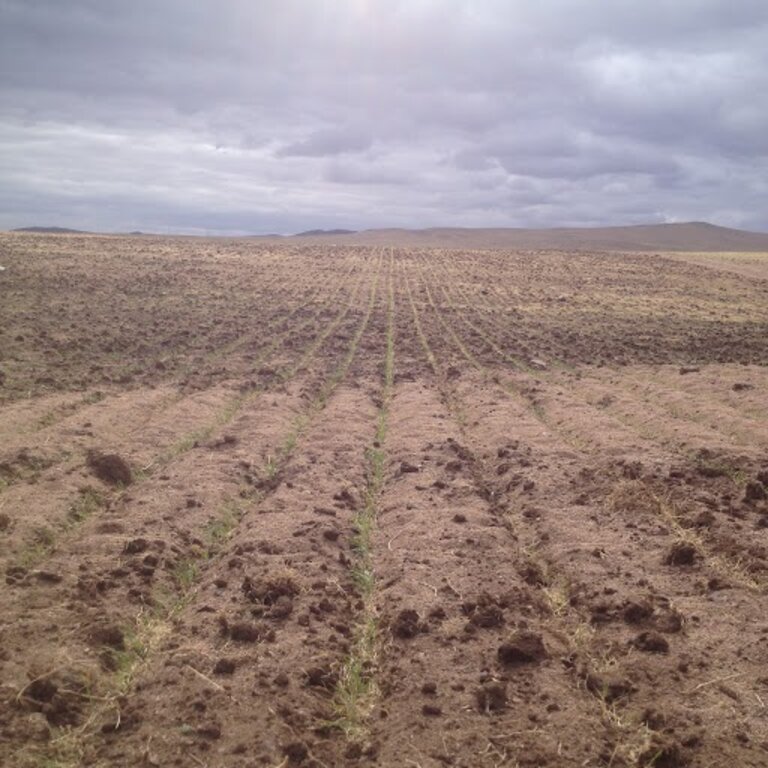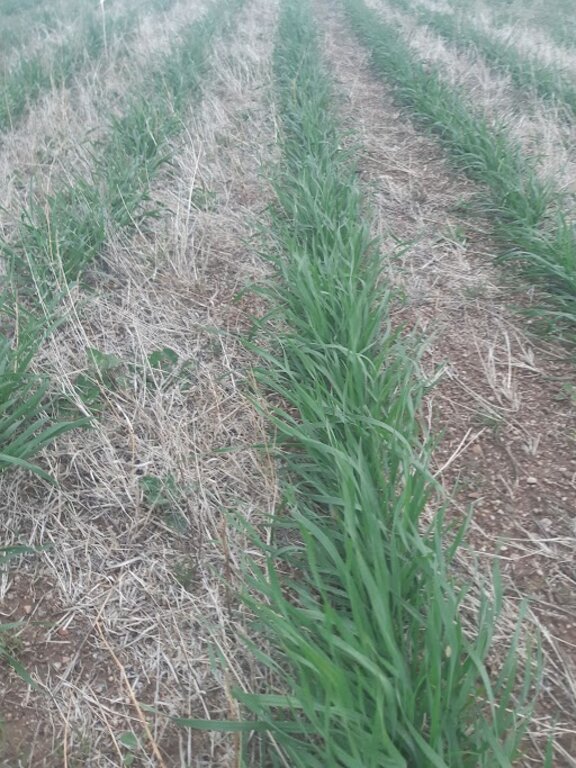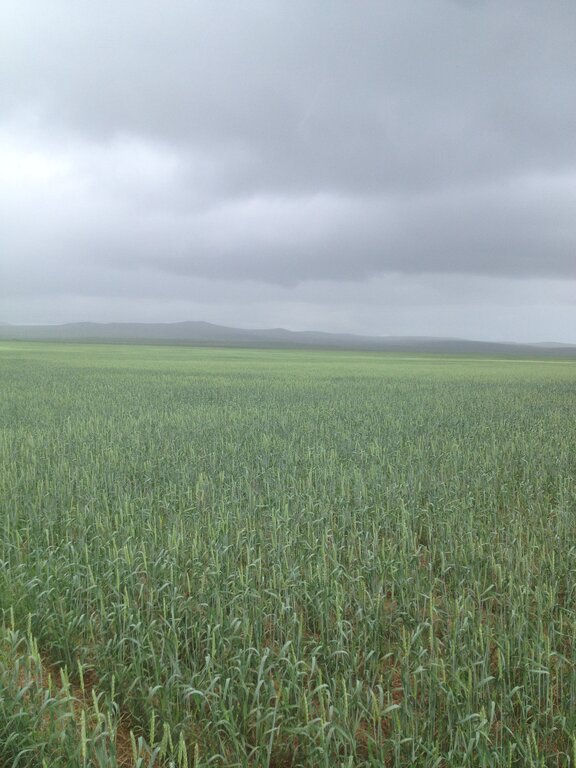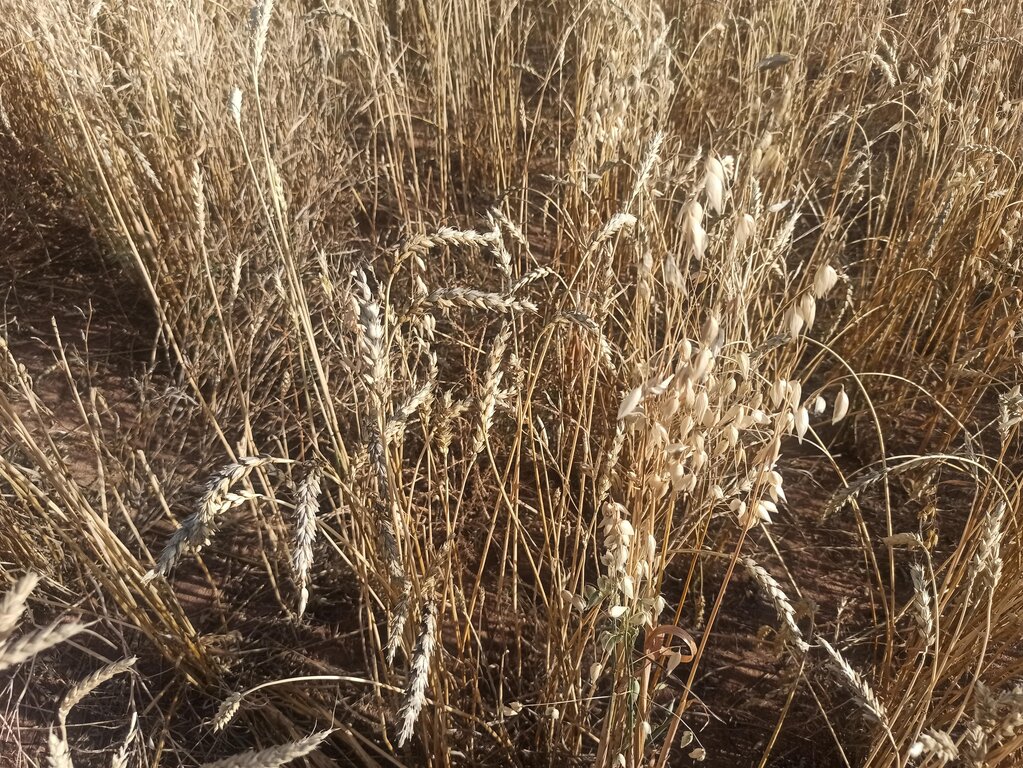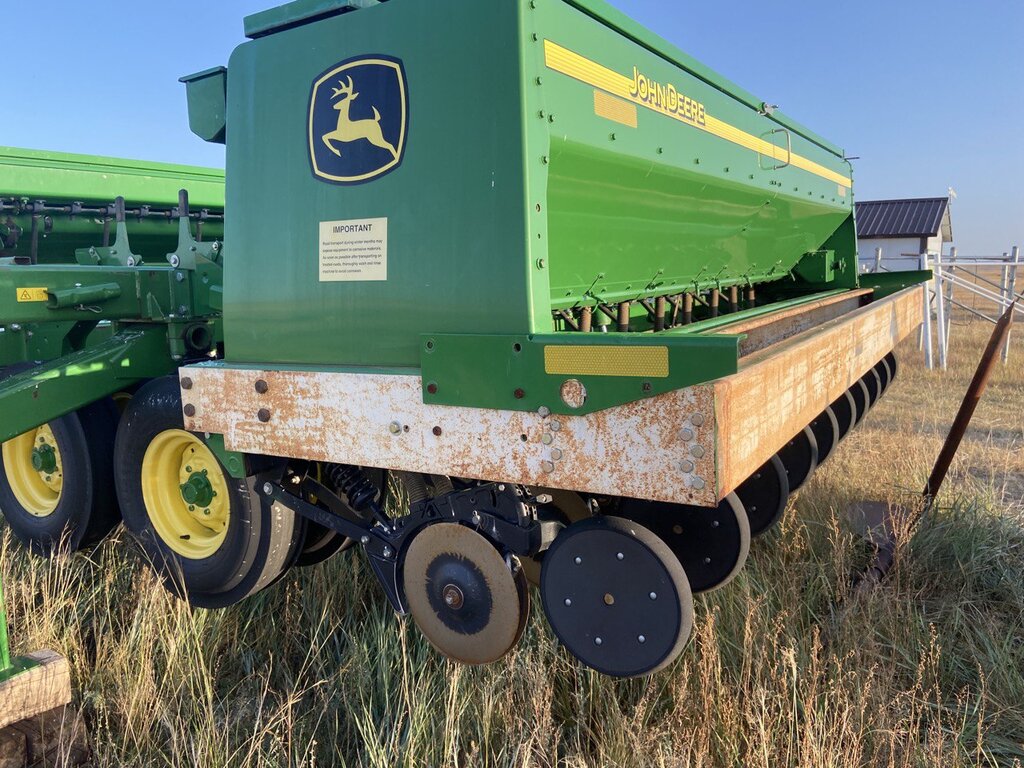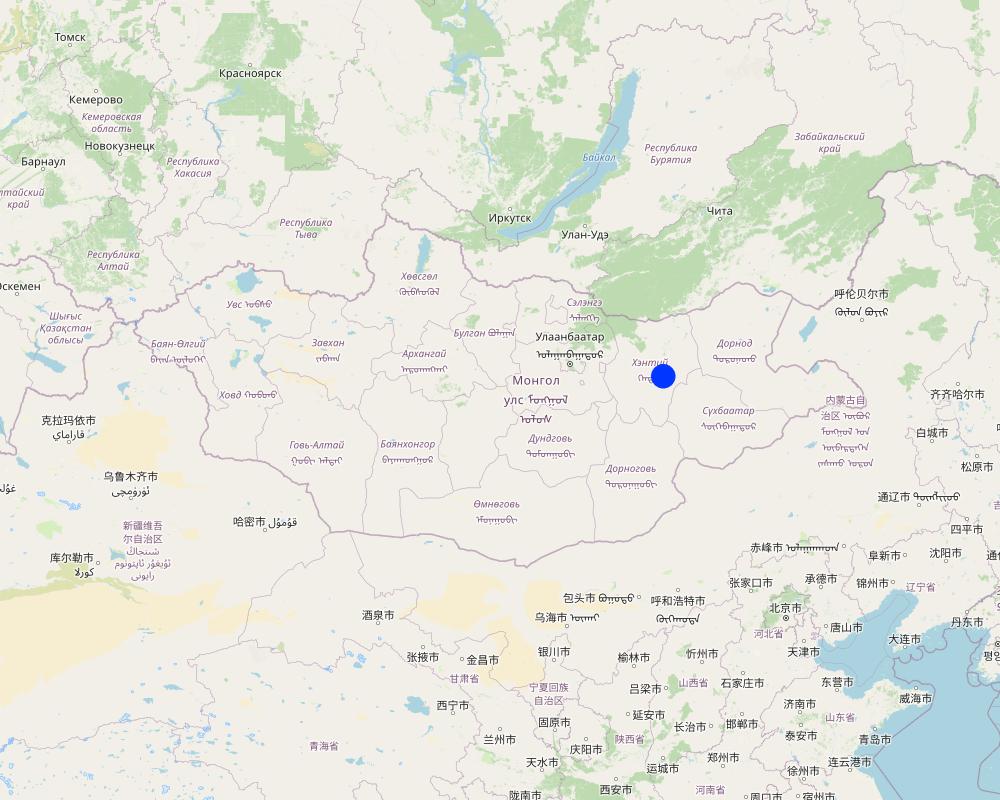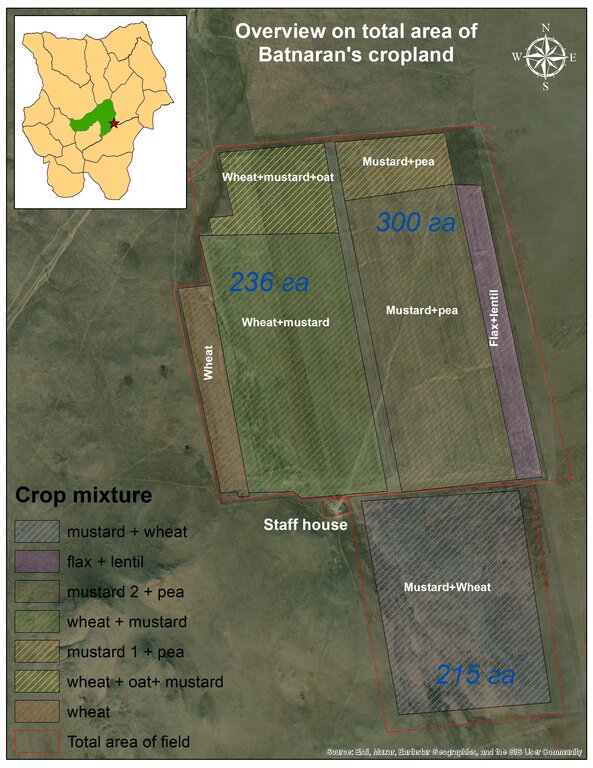Conservation agriculture to restore abandoned cropland [Mongolia]
- Creation:
- Update:
- Compiler: Otgontsetseg Davaanyam
- Editor: Mandakh Nyamtseren
- Reviewer: Rima Mekdaschi Studer
Khurs Khamgaalliin gazar tarialan
technologies_6938 - Mongolia
View sections
Expand all Collapse all1. General information
1.2 Contact details of resource persons and institutions involved in the assessment and documentation of the Technology
Key resource person(s)
land user:
Batdeleg Batnaran
Khentiin Tarialan LLC
Mongolia
Name of project which facilitated the documentation/ evaluation of the Technology (if relevant)
Decision Support for Mainstreaming and Scaling out Sustainable Land Management (GEF-FAO / DS-SLM)Name of the institution(s) which facilitated the documentation/ evaluation of the Technology (if relevant)
Mongolian Academy of Sciences, Institute of Geography and Geoecology (IGG) - Mongolia1.3 Conditions regarding the use of data documented through WOCAT
The compiler and key resource person(s) accept the conditions regarding the use of data documented through WOCAT:
Yes
1.4 Declaration on sustainability of the described Technology
Is the Technology described here problematic with regard to land degradation, so that it cannot be declared a sustainable land management technology?
No
Comments:
This technology is a SLM technology, because it returned abandoned land to productive agricultural land while building up soil health.
1.5 Reference to Questionnaire(s) on SLM Approaches (documented using WOCAT)
2. Description of the SLM Technology
2.1 Short description of the Technology
Definition of the Technology:
This technology aimed to restore abandoned cropland which was used for crop and fodder production during the 1970s-1980s. Since 2016, the farmer applied conservation agriculture and mixed cropping to reduce land degradation, revive cropping practices, increase land productivity for agriculture and enhance soil health.
2.2 Detailed description of the Technology
Description:
The land in Kherlen soum, Khentii province, spanning 500 hectares, was used for crop production and later for producing fodder for livestock. However, since 1984, it has been left abandoned. To rehabilitate the area and revive cropland, conservation agriculture combined with mixed cropping was introduced in 2014.
Mixed cropping encompasses various agrotechnical practices that involve the cultivation of different crops together, making use of their ability to interact with each other. The aim is to sustain crop yield in regions with limited moisture, protect the soil surface, regulate soil moisture levels, and enhance the availability of micro and macro-nutrients. In Kherlen soum, Khentii province, mixed cropping was implemented by planting seed mixtures of different proportions, taking into consideration the specific requirements and differences among various crops. Presently, annual crops such as mustard, peas, Cape rice, and wheat, rye along with rapeseeds, are successfully cultivated mixed and/or in rotation in the area.
Conservation agriculture in soil protection agriculture offers several advantages, including the enhancement of soil, its resilience to external factors such as erosion by wind, regulation of soil fertility and microorganism populations, avoidance of highly toxic substances in agriculture, and increased productivity. One significant aspect of conservation agriculture is using no-till and direct sowing techniques to minimize soil disturbance. During harvesting, only the crop heads are collected, while the remaining rootsystems and stems are left in and above the soil contributing to increasing soil organic matter. Other residues and parts of plants, such as straw/ stalks and leaves, are shredded and spread across the field to reduce soil moisture evaporation and protect it from the sun and wind. Soil erosion by wind can be mitigated by covering the soil as much and long as possible either by leaving the crop residues on the soil and/or including cover crops into crop rotations. Furthermore, this technology improves the soil health and microenvironment/ microclimate.
To initiate and implement this technology, the land user leased most of his land through a proposal, aimed at improving the soil quality of abandoned land, to the local government, and also purchased a certain amount of land through a land auction announced on the government website. Initial preparation of land for sowing consisted of removing stones from the field and spraying herbicides to get rid of weeds and their seeds. A minimal dose of herbicides with low toxicity is used to control the growth and spread of weed plants commonly found in abandoned fields. Later on mustard was incorporated into mixed cropping and rotations suppressing the growth of weed.
In the first year, the farmer planted a mixture of mustard, oilseed rape and lucerne to enhance soil penetration and break up compacted soil, as well as wheat in a 40 cm strip on stony soil with low fertility. First few years 2014-2018), the farmer didn’t harvest all the yields to keep the soil covered and improve the soil quality.
In 2019 the farmer built a fence to protect against grazing and yields significantly improved. Moreover, various equipment such as direct seeder for no till or minimum tillage crop cultivation, combine harvester, tractor, herbicide spraying machine and seed sorting machines to improve the quality of produce for the market (clean and separate seeds of different sizes and different types of crops) were bought with a bank loan.
A comprehensive knowledge of the interactions and symbiotic relationships between different crops is also essential to plan for crop mixtures and rotations. Crop morphology such as root system, competition for nutrients and water should be considered. Mustard-pea mixture facilitates harvesting as pea is difficult to harvest in monoculture and mustard can provide biological weed control.
He divided the land / field into 12 plots, which were planted with different crop mixtures and in rotation, maintaining soil fertility, limiting pests and diseases, and increasing crop yields. Legumes can improve soil fertility by adding nitrogen to the soil. The farmer practiced five-field rotation in his cropland using legumes including pea, bean, lentils and alfalfa. The rotation plan depends on climate conditions.
The levels of potassium and phosphorous in the soil were monitored and regularly measured. Only when a deficit occurred the land user used mineral fertilizers.
According to farmers who practice conservation agriculture and mixed farming, these technologies effectively maintains soil stability, ensuring its long-term sustainability.
2.3 Photos of the Technology
2.5 Country/ region/ locations where the Technology has been applied and which are covered by this assessment
Country:
Mongolia
Region/ State/ Province:
Khentii province
Further specification of location:
Kherlen soum, Takhilgat bag
Specify the spread of the Technology:
- evenly spread over an area
If the Technology is evenly spread over an area, specify area covered (in km2):
8.0
If precise area is not known, indicate approximate area covered:
- 1-10 km2
Is/are the technology site(s) located in a permanently protected area?
No
Comments:
The area is not a part of the permanently protected area.
Map
×2.6 Date of implementation
Indicate year of implementation:
2014
If precise year is not known, indicate approximate date:
- less than 10 years ago (recently)
2.7 Introduction of the Technology
Specify how the Technology was introduced:
- through land users' innovation
- during experiments/ research
Comments (type of project, etc.):
The farmer planted mustard, rapeseed, and alfalfa in rotation and mixture based on national and international experiences and research on conservation agriculture. These plants have taproot systems that penetrate the soil, enhance water uptake from lower soil depth and make the hardpan soil more porous. After implementing this technology, the land user observed and monitored the field himself. He observed that the retention of soil moisture has increased, soil erosion has significantly decreased, and biological diversity, including microorganisms, insects, and birds, has also increased due to the presence of cover plants.
3. Classification of the SLM Technology
3.1 Main purpose(s) of the Technology
- improve production
- reduce, prevent, restore land degradation
- preserve/ improve biodiversity
- adapt to climate change/ extremes and its impacts
- create beneficial economic impact
3.2 Current land use type(s) where the Technology is applied
Land use mixed within the same land unit:
No

Cropland
- Annual cropping
Annual cropping - Specify crops:
- cereals - barley
- cereals - oats
- cereals - wheat (spring)
- fibre crops - flax, hemp, other
- fodder crops - alfalfa
- legumes and pulses - lentils
- legumes and pulses - peas
- oilseed crops - sunflower, rapeseed, other
- seed crops - sesame, poppy, mustard, other
Annual cropping system:
Wheat or similar rotation with hay/pasture
Number of growing seasons per year:
- 1
Specify:
Plant seeds are sown in April and harvested in August to September.
Is intercropping practiced?
No
Is crop rotation practiced?
Yes
If yes, specify:
Entire field/ area was divided into 5 main sections, allowing to practice crop rotation. In general, a rotation consists of cereal crops follow by broad leaved crops. Within one plot, the land user decides the mixture of crop depending on the weather condition in the year. If a mixture of mustard-wheat was planted in this year, another crop mixture should be planted in the next year.
3.3 Has land use changed due to the implementation of the Technology?
Has land use changed due to the implementation of the Technology?
- Yes (Please fill out the questions below with regard to the land use before implementation of the Technology)
Land use mixed within the same land unit:
No

Unproductive land
Specify:
Abandoned land
Remarks:
Monoculture crops were planted in the area during the socialist period, and it was left unused and abandoned since 1986. Therefore, the productivity and fertility of the land decreased.
3.4 Water supply
Water supply for the land on which the Technology is applied:
- rainfed
Comments:
Irrigation systems are not used throughout the field.
3.5 SLM group to which the Technology belongs
- rotational systems (crop rotation, fallows, shifting cultivation)
- improved ground/ vegetation cover
- minimal soil disturbance
3.6 SLM measures comprising the Technology

agronomic measures
- A1: Vegetation/ soil cover
- A2: Organic matter/ soil fertility
- A3: Soil surface treatment
- A5: Seed management, improved varieties
- A6: Residue management
A3: Differentiate tillage systems:
A 3.1: No tillage
A6: Specify residue management:
A 6.4: retained

management measures
- M1: Change of land use type
Comments:
Abandoned land had been converted into annual cropland. According to the classification of Mongolian Land Unified Fund, land was classified as abandoned land and changed into agricultural land after starting to use it.
3.7 Main types of land degradation addressed by the Technology

soil erosion by wind
- Et: loss of topsoil
- Eo: offsite degradation effects

chemical soil deterioration
- Cn: fertility decline and reduced organic matter content (not caused by erosion)

biological degradation
- Bc: reduction of vegetation cover
- Bq: quantity/ biomass decline
- Bs: quality and species composition/ diversity decline
Comments:
The soil in the abandoned land became infertile due to water and wind erosion, and thus, there had been a decrease in biodiversity in the soil as well as in plant diversity and productivity.
3.8 Prevention, reduction, or restoration of land degradation
Specify the goal of the Technology with regard to land degradation:
- restore/ rehabilitate severely degraded land
Comments:
The technology aims to revive the agricultural practice in abandoned cropland, protect the soil from erosion, enhance its moisture and organic matter, and improve biological diversity by planting a variety of plants, thereby allowing opportunities for long-term sustainable use.
4. Technical specifications, implementation activities, inputs, and costs
4.1 Technical drawing of the Technology
Technical specifications (related to technical drawing):
This diagram shows how the crop mix was distributed across the field in 2023 (on different plots). Entire field was divided into 5 main sections which are intended for crop rotation and also several small sections which are for ensuring seed source. More than 20 types of crops were planted in the whole field. A five-field rotation is practiced in this cropland with a sequence of cereal grains (wheat, barley, oats, etc.) followed by leafy plants (flax, lentils, peas, mustard, etc.), depending on the climatic conditions of the year. In dry years, the land user prefers to grow cereals and flax, which are more resistant to drought, and then rotate cereals with a mixture of leafy plants the following year. In years with good humidity, on the other hand, a mixture of mustard + peas + oats + lentils is suitable. The advantages of this mixture is to improve soil fertility and to control diseases and pest. In addition, soil remains covered against soil erosion. Inclusion of different crops means also increase in agrobiodiversity.
Author:
Ankhbayar N., Gereltuya G.
Date:
02/10/2023
4.2 General information regarding the calculation of inputs and costs
Specify how costs and inputs were calculated:
- per Technology area
Indicate size and area unit:
800 ha
other/ national currency (specify):
Tugrik
If relevant, indicate exchange rate from USD to local currency (e.g. 1 USD = 79.9 Brazilian Real): 1 USD =:
3453.0
Indicate average wage cost of hired labour per day:
50000 - 100000 Tugrik
4.3 Establishment activities
| Activity | Timing (season) | |
|---|---|---|
| 1. | Build fence | before sowing |
| 2. | Prepare (picking stones) and plough land | before sowing |
| 3. | Buy and spray herbicide | before sowing |
| 4. | Purchase tractor | before sowing |
| 5. | Purchase direct seeder | before sowing |
| 6. | Purchase combine harvester | before sowing |
| 7. | Purchase spray machine | before sowing |
| 8. | Purchase seed cleaning machine | before sowing |
| 9. | Purchase stone picker machine | before sowing |
| 10. | Purchase or rent pile machine for fencing | before sowing |
| 11. | Purchase silos | before harvesting |
| 12. | Storage shed | before harvesting |
Comments:
Establishing a fence before the technology is an essential activity to protect from grazing and retain cover plants. The farmer empahsized that it is important to choose materials with good quality for building fence. He used imported fencing material from Canada of which the price was higher than average local market price.
4.4 Costs and inputs needed for establishment
| Specify input | Unit | Quantity | Costs per Unit | Total costs per input | % of costs borne by land users | |
|---|---|---|---|---|---|---|
| Labour | Build fence | person | 2.0 | 15000000.0 | 30000000.0 | 100.0 |
| Labour | Spray herbicide | person | 2.0 | 350000.0 | 700000.0 | 100.0 |
| Labour | Sowing | person | 1.0 | 4000000.0 | 4000000.0 | 100.0 |
| Labour | Stone picking | person | 1.0 | 4800000.0 | 4800000.0 | 100.0 |
| Equipment | Tractor | piece | 1.0 | 220000000.0 | 220000000.0 | 100.0 |
| Equipment | Direct seeder | piece | 1.0 | 224000000.0 | 224000000.0 | 100.0 |
| Equipment | Combine harvester | piece | 2.0 | 397000000.0 | 794000000.0 | 100.0 |
| Equipment | Agriculture spray machine | piece | 1.0 | 170000000.0 | 170000000.0 | 100.0 |
| Equipment | Stone picker machine | piece | 1.0 | 15000000.0 | 15000000.0 | 100.0 |
| Equipment | Seed cleaning machine | piece | 3.0 | 35000000.0 | 105000000.0 | 100.0 |
| Equipment | Pile machine for fencing | piece | 1.0 | 6900000.0 | 6900000.0 | 100.0 |
| Equipment | Silos | tonnes (holding capacity) | 700.0 | 714285.72 | 500000004.0 | 100.0 |
| Plant material | Seeds first year | tonnes | 70.5 | 4400000.0 | 310200000.0 | 100.0 |
| Fertilizers and biocides | Herbicide | l | 2400.0 | 8000.0 | 19200000.0 | 100.0 |
| Construction material | Poles and net for fence | km | 25.0 | 10800000.0 | 270000000.0 | 100.0 |
| Other | Land lease | ha | 800.0 | 500000.0 | 400000000.0 | 100.0 |
| Total costs for establishment of the Technology | 3073800004.0 | |||||
| Total costs for establishment of the Technology in USD | 890182.45 | |||||
Comments:
The implementation of conservation agriculture and mixed cropping was self-funded by land user. For certain initial investments he took a loan from the bank. The fence materials were imported from Canada, for its good quality.
4.5 Maintenance/ recurrent activities
| Activity | Timing/ frequency | |
|---|---|---|
| 1. | Sowing/ direct seeding | April to May per year |
| 2. | Harvesting and separating harvested seeds | once in August to September |
| 3. | Reproducing seed for own use and sowing | after harvest |
| 4. | Spray herbicide | if necessary, once in 2-3 year |
| 5. | Monitoring on plant development (e.g. germination, flowering, maturity) | at each plant development stage |
| 6. | Monitoring soil fertility | once a year, in August |
Comments:
Soil samples are taken and sent to a specialized laboratory for analysis.
4.6 Costs and inputs needed for maintenance/ recurrent activities (per year)
| Specify input | Unit | Quantity | Costs per Unit | Total costs per input | % of costs borne by land users | |
|---|---|---|---|---|---|---|
| Labour | Spray herbicide | person | 2.0 | 1400000.0 | 2800000.0 | 100.0 |
| Labour | Harvesting | person | 4.0 | 1500000.0 | 6000000.0 | 100.0 |
| Labour | Separating seeds | person | 2.0 | 1000000.0 | 2000000.0 | 100.0 |
| Labour | Sowing seeds | person | 2.0 | 1500000.0 | 3000000.0 | 100.0 |
| Equipment | Spare parts and maintenance of machines | ha | 800.0 | 10500.0 | 8400000.0 | 100.0 |
| Equipment | Spraying machine (fuel) | l/year | 400.0 | 2400.0 | 960000.0 | 100.0 |
| Equipment | Sowing machine (fuel) | l/year | 4000.0 | 2400.0 | 9600000.0 | 100.0 |
| Equipment | Combine harvesting machine (fuel) | l/year | 4000.0 | 2400.0 | 9600000.0 | 100.0 |
| Plant material | Seeds | tonne/year | 13.7 | 4400000.0 | 60280000.0 | 100.0 |
| Fertilizers and biocides | Herbicide (different types) | l | 1.0 | 30000.0 | 30000.0 | 100.0 |
| Other | Land use tax | MNT/year | 1.0 | 1900000.0 | 1900000.0 | 100.0 |
| Other | Soil sampling and testing | MNT/year | 1.0 | 830000.0 | 830000.0 | 100.0 |
| Total costs for maintenance of the Technology | 105400000.0 | |||||
| Total costs for maintenance of the Technology in USD | 30524.18 | |||||
Comments:
The amount of herbicide used in a given year depends on the type of weed and its distribution. Initially, the land user spent 19 million (2400 litres) on herbicide to prepare the field for cultivation, and the price was relatively low compared to today (8000 MNT on average). But, in 2022, different types of herbicides were bought for different types of weeds distributed in the field and 120 million MNT (1800 litres) were spent because the price became high compared to other years due to the border closure (COVID). But in 2023, only 30 000 MNT (1 litre) was spent on herbicides in the whole field.
The land user and a permanent help receive a monthly salary.
4.7 Most important factors affecting the costs
Describe the most determinate factors affecting the costs:
Factors that mainly affect the cost are inflation and the MNT exchange rate (mainly relevant when purchasing imported products). In addition, in the event of extreme weather and disastrous conditions, extra labor may be required to mitigate damage.
5. Natural and human environment
5.1 Climate
Annual rainfall
- < 250 mm
- 251-500 mm
- 501-750 mm
- 751-1,000 mm
- 1,001-1,500 mm
- 1,501-2,000 mm
- 2,001-3,000 mm
- 3,001-4,000 mm
- > 4,000 mm
Specify average annual rainfall (if known), in mm:
150.00
Indicate the name of the reference meteorological station considered:
Undurkhaan
Agro-climatic zone
- semi-arid
This region includes a region with harsh cold winters and dry summers. The average annual air temperature is -0.2 celsius, and the difference between day and night temperature ranges from 13 to 15 degrees.
5.2 Topography
Slopes on average:
- flat (0-2%)
- gentle (3-5%)
- moderate (6-10%)
- rolling (11-15%)
- hilly (16-30%)
- steep (31-60%)
- very steep (>60%)
Landforms:
- plateau/plains
- ridges
- mountain slopes
- hill slopes
- footslopes
- valley floors
Altitudinal zone:
- 0-100 m a.s.l.
- 101-500 m a.s.l.
- 501-1,000 m a.s.l.
- 1,001-1,500 m a.s.l.
- 1,501-2,000 m a.s.l.
- 2,001-2,500 m a.s.l.
- 2,501-3,000 m a.s.l.
- 3,001-4,000 m a.s.l.
- > 4,000 m a.s.l.
Indicate if the Technology is specifically applied in:
- concave situations
5.3 Soils
Soil depth on average:
- very shallow (0-20 cm)
- shallow (21-50 cm)
- moderately deep (51-80 cm)
- deep (81-120 cm)
- very deep (> 120 cm)
Soil texture (topsoil):
- coarse/ light (sandy)
Soil texture (> 20 cm below surface):
- medium (loamy, silty)
Topsoil organic matter:
- low (<1%)
5.4 Water availability and quality
Ground water table:
5-50 m
Availability of surface water:
good
Water quality (untreated):
good drinking water
Water quality refers to:
both ground and surface water
Is water salinity a problem?
No
Is flooding of the area occurring?
Yes
Regularity:
episodically
Comments and further specifications on water quality and quantity:
It depends on intensity of rainfall.
5.5 Biodiversity
Species diversity:
- medium
Habitat diversity:
- low
Comments and further specifications on biodiversity:
Based on an animal and plant richness research study, biodiversity in this region is classified as moderate. After the implementation of the technology, more species of insects and birds were found in the fields due to the increase in agrobiodiversity.
5.6 Characteristics of land users applying the Technology
Sedentary or nomadic:
- Sedentary
Market orientation of production system:
- commercial/ market
Off-farm income:
- less than 10% of all income
Relative level of wealth:
- average
Individuals or groups:
- employee (company, government)
Level of mechanization:
- mechanized/ motorized
Gender:
- men
Age of land users:
- middle-aged
Indicate other relevant characteristics of the land users:
Khentiin Tarialan LLC is a company with theland user and an aid are employed and with seasonally hired labour.
5.7 Average area of land used by land users applying the Technology
- < 0.5 ha
- 0.5-1 ha
- 1-2 ha
- 2-5 ha
- 5-15 ha
- 15-50 ha
- 50-100 ha
- 100-500 ha
- 500-1,000 ha
- 1,000-10,000 ha
- > 10,000 ha
Is this considered small-, medium- or large-scale (referring to local context)?
- medium-scale
Comments:
Based on standards, the area used by the land user is considered to be a medium-scale.
5.8 Land ownership, land use rights, and water use rights
Land ownership:
- state
Land use rights:
- leased
Water use rights:
- individual
Are land use rights based on a traditional legal system?
No
Comments:
Land is rented for a period of 15 years and when duration is over, the contract can be extended. Land users pay land use tax every year. Land use rights for agricultural production was leased by auction.
5.9 Access to services and infrastructure
health:
- poor
- moderate
- good
education:
- poor
- moderate
- good
technical assistance:
- poor
- moderate
- good
employment (e.g. off-farm):
- poor
- moderate
- good
markets:
- poor
- moderate
- good
energy:
- poor
- moderate
- good
roads and transport:
- poor
- moderate
- good
drinking water and sanitation:
- poor
- moderate
- good
financial services:
- poor
- moderate
- good
6. Impacts and concluding statements
6.1 On-site impacts the Technology has shown
Socio-economic impacts
Production
crop production
Quantity before SLM:
0
Quantity after SLM:
25 centner/ha
Comments/ specify:
It is important to note that crop production is highly dependent on weather conditions. In 2021, when there was enough precipitation, a yield of 25 centner/ha was achieved. However, in 2014-2016, when technology implementation was just starting in severely degraded land and coincided with drought, there were occasions where all yield was lost.
crop quality
Comments/ specify:
Specific weight, indicating seed quality, of grain reached 900 g/l and, gluten content of wheat always meets the requirements of first grade of food.
fodder production
Comments/ specify:
Comparisons between 2018 and 2022 indicate that the average length of the wheat grain head increased and reached 10 - 12 centimeters by 1st July, resulting in a higher yield. Oats and wheat are harvested for fodder production while peas are supplied to chicken farms.
fodder quality
Comments/ specify:
In terms of wheat quality, it is classified into first grade. The protein content of Bayalag variety of peas is 18-20%, starch content is 26-35%.
risk of production failure
Comments/ specify:
We concluded that this technology can overcome any risks related to labor and expenses, because sowing time is different for many types of crops, reducing the amount of expenses and labor load.
product diversity
Quantity before SLM:
1
Quantity after SLM:
20
Comments/ specify:
About 20 species of plants are being cultivated.
Income and costs
expenses on agricultural inputs
Quantity before SLM:
9 centner
Quantity after SLM:
3 centner
Comments/ specify:
The amount of seeds used for planting is lower, the seeds can be used for the next year cultivation: The spread of plant diseases / pests and use of pesticides is relatively low. Herbizides and fertilizers are not applied in this technology. Thus, there is no expense on that.
farm income
Quantity after SLM:
5 centner
Comments/ specify:
The yield is dependent on the climatic conditions of the year. In wheat yield, 3 centners were spent on sowing and 5 centners were obtained for each hectare when the weather was not favorable and precipitation was relatively low. Therefore, the net income is 2 centners in this case.
workload
Quantity before SLM:
4
Quantity after SLM:
2
Comments/ specify:
Sowing time is different for many types of crops, so it does not requires a high number of labor. 2 persons typically work on the entire area throughout the year and, 2 more persons are employed during harvesting.
Socio-cultural impacts
food security/ self-sufficiency
SLM/ land degradation knowledge
Comments/ specify:
Mentorship program for other farmers is organized.
Ecological impacts
Water cycle/ runoff
evaporation
Comments/ specify:
Due to cover crops and residue left on the soil, it reduces the amount of water evaporation from the soil and keeps the soil moisture .
Soil
soil moisture
Comments/ specify:
Cover crops and plant residues left on the soil surface protect against wind erosion, reduces soil water evaporation and improves soil moisture content.
soil cover
Quantity before SLM:
0 cm
Quantity after SLM:
2 cm
Comments/ specify:
Before the technology was introduced, the field was barely covered with plants and the topsoil had been severely eroded by the wind, resulting in a loss of fertility and covered with gravel.
soil loss
Comments/ specify:
Snow cover in winter, has an important effect on protecting the soil from wind erosion in the spring.
nutrient cycling/ recharge
soil organic matter/ below ground C
Comments/ specify:
It is believed that when the content of organic matter in the soil increases by 1 percent, the water holding capacity of the soil increases by 4 percent. From this point of view, it can be concluded that the content of organic matter has improved.
Biodiversity: vegetation, animals
Vegetation cover
Comments/ specify:
Before the technology, vegetation cover was sparse and there were only 2-3 species of weeds in a square of 1m x 1m.
biomass/ above ground C
Comments/ specify:
Aboveground biomass increased. Prairie sagebrush is predominating in natural vegetation community.
plant diversity
animal diversity
Comments/ specify:
According to the results of soil sampling, the ratio of microorganisms in the soil has increased. It is also clearly observed that the variety of insects and the birds that feed on them have increased due to the rise in plant species.
beneficial species
Comments/ specify:
From 2019, mushrooms started growing in the field. Flaxes, forming symbioses with fungus, are planted in order to enhance distribution of fungus in soil. Fungus has a positive effect on soil quality.
pest/ disease control
Comments/ specify:
Mustard and peas have been observed to limit the growth of weeds such as hogweed. Additionally, mustard releases two powerful substances that can help limit the spread of diseases.
Climate and disaster risk reduction
flood impacts
Quantity before SLM:
high
Quantity after SLM:
low
Comments/ specify:
Sown stands and plant cover can mitigate heavy flooding, then, the risk of washing away the fertile layer of the soil can be reduced. In addition, the stands will retain plant residues and other objects carried by the flood water. It can also be composted into the soil.
drought impacts
Quantity before SLM:
high
Quantity after SLM:
low
Comments/ specify:
Because the soil moisture content is good compared to other areas, the yield is higher in drought years and soil erosion is less.
wind velocity
Comments/ specify:
Wind velocity is high in this region. We are thinking about establishing windbreak in the field.
Specify assessment of on-site impacts (measurements):
In winter, vertical stems of plants hold snow well. It has an important effect on soil protection and increasing soil moisture in spring.
6.2 Off-site impacts the Technology has shown
wind transported sediments
Comments/ specify:
Improves wind cleanliness by catching organic material and other residues carried by the wind.
damage on neighbours' fields
Comments/ specify:
The technology can reduce the risk of flooding
Specify assessment of off-site impacts (measurements):
The land user, implementing the technology, made a conclusion based on his own observations.
6.3 Exposure and sensitivity of the Technology to gradual climate change and climate-related extremes/ disasters (as perceived by land users)
Gradual climate change
Gradual climate change
| Season | increase or decrease | How does the Technology cope with it? | |
|---|---|---|---|
| annual temperature | increase | well | |
| seasonal temperature | summer | increase | moderately |
| seasonal temperature | winter | decrease | not well |
| seasonal rainfall | summer | decrease | not well |
| seasonal rainfall | spring | decrease | moderately |
Climate-related extremes (disasters)
Meteorological disasters
| How does the Technology cope with it? | |
|---|---|
| local snowstorm | moderately |
| local sandstorm/ duststorm | not well |
Climatological disasters
| How does the Technology cope with it? | |
|---|---|
| heatwave | very well |
| drought | very well |
Biological disasters
| How does the Technology cope with it? | |
|---|---|
| epidemic diseases | well |
Other climate-related consequences
Other climate-related consequences
| How does the Technology cope with it? | |
|---|---|
| reduced growing period | not well |
6.4 Cost-benefit analysis
How do the benefits compare with the establishment costs (from land users’ perspective)?
Short-term returns:
negative
Long-term returns:
positive
How do the benefits compare with the maintenance/ recurrent costs (from land users' perspective)?
Short-term returns:
slightly positive
Long-term returns:
positive
Comments:
Establishment cost for 800 hectare of agricultural farm was approximately 3.6 billion MNT and there is no income in first several years. In long term, annual cost have decreased and, annual income became 320 million MNT, net income 128 million MNT. Thus, income can be positive in long term.
6.5 Adoption of the Technology
- single cases/ experimental
If available, quantify (no. of households and/ or area covered):
1 household
Of all those who have adopted the Technology, how many did so spontaneously, i.e. without receiving any material incentives/ payments?
- 91-100%
Comments:
All expenses were paid by own.
6.6 Adaptation
Has the Technology been modified recently to adapt to changing conditions?
Yes
If yes, indicate to which changing conditions it was adapted:
- climatic change/ extremes
Specify adaptation of the Technology (design, material/ species, etc.):
Crop rotation decisions are made based on spring weather conditions and soil moisture of the planting year. In some years, the crop rotation and mixture is not changed.
6.7 Strengths/ advantages/ opportunities of the Technology
| Strengths/ advantages/ opportunities in the land user’s view |
|---|
| The technology provides higher yields than traditional monoculture in climate condition in Mongolia. |
| The technology allows to plant crops early in spring, because soil moisture absorbed from winter snow provide convenient condition. |
| Soil erosion and sand accumulation have been significantly reduced. |
| Conservation agricuture can significantly improve the physical properties of soil, providing sustainable and ecological rehabilitation of abandoned land. |
| Over time, soil fertility should improve as a result of increased soil organic matter. |
| Strengths/ advantages/ opportunities in the compiler’s or other key resource person’s view |
|---|
| Abandoned land can be restored at the lowest cost. |
| Soil conservation technology was used without reducing the soil fertility as well as returning of abandoned land into use. |
| The use of machinery in medium-scale farming is advantageous because it reduces labor costs. |
| Planting with low seed rates increases the economic efficiency in the long term. |
6.8 Weaknesses/ disadvantages/ risks of the Technology and ways of overcoming them
| Weaknesses/ disadvantages/ risks in the land user’s view | How can they be overcome? |
|---|---|
| Due to climate change and aridity, in some years, crop loss occurs during the planting and growing period. | Install irrigation system for seasonal irrigation or irrigation when needed. |
| When harvesting, it is necessary to leave a plant cover as high as possible, which requires particular harvesting machine. | A combine harvester or a machine (head stripper) that collects only heads of the crop is required. |
| Weaknesses/ disadvantages/ risks in the compiler’s or other key resource person’s view | How can they be overcome? |
|---|---|
| The use of imported seeds increases the cost. | To cultivate crop seeds in small isolated areas. |
| With climate change, the lack of irrigation facilities increases risk of production failure. | More water harvesting techniiques and soil moisture conservation/accumulation technologies to be identified and implemented. Installation of an irrigation system for supplementary irrigation or irrigation when needed. |
| It is difficult to separate the seeds after harvesting due to the lack of techniques and appropriate equipement. Sorted seeds will increase market value. | Improve seed sorting mechanism. |
| Due to the lack of appriopriate harvesting equipment, the crop cannot be harvested completely. | Buy a new type of combine harvester or rent from others. |
7. References and links
7.1 Methods/ sources of information
- interviews with land users
The information was acquired from land users who adopted the technology.
When were the data compiled (in the field)?
02/10/2023
7.2 References to available publications
Title, author, year, ISBN:
Guidelines for Intercropping. Charles L. Mohler, Sue Ellen Johnson. 2009. ISBN 978-1-933395-21-0
Available from where? Costs?
https://www.sare.org/wp-content/uploads/Crop-Rotation-on-Organic-Farms.pdf
Title, author, year, ISBN:
Encyclopedia of Biodiversity, Reference Work. Second Edition. 2013. ISBN 978-0123847195
Available from where? Costs?
https://www.amazon.com/Encyclopedia-Biodiversity-2nd-Set/dp/0123847192
7.3 Links to relevant online information
Title/ description:
Intercropping: benefits and types
URL:
https://geopard.tech/blog/what-is-intercropping-and-how-does-it-work/
Title/ description:
Intercropping: Ergonomic And Efficient Farming
URL:
https://eos.com/blog/intercropping/
Title/ description:
INTERCROPPING
URL:
http://nwrm.eu/measure/intercropping
Links and modules
Expand all Collapse allLinks
No links
Modules
No modules


